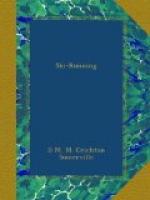HISTORY OF SKI-ING
Very little is known of the early history of Ski-ing. Doctor Henry Hoek in his book “Der Schi” gives a very interesting chapter tracing the use of Skis back to the earliest records. He thinks that Skis were used by Central Asian races thousands of years B.C. and long before they were used in Europe. According to his book the word “Schi” is derived from the Gothic “Skaidan,” the German “Scheiden,” Latin “Scindere,” and so on. All these words mean split or divide, and might be used to describe the split wood of which Skis are made or their action in dividing or separating the snow through which they pass.
Doctor Hoek further says that early records show how Ski-ing was a sport practised by knights, and he quotes Rognwald of Orkney (1159 A.D.) who states that he could run on Skis.
The Swedish Bishop Magnus writes in 1533 of the way in which the Norwegians used Skis for traversing country when hunting.
During the Swedish and Norwegian war in 1808 the Norwegian Army included 2,000 Ski runners, but the use of Skis does not seem to have come into warfare again until the Great War of 1914-1918, when the Swiss, Austrians and Italians all used them on the Alpine frontiers.
The modern and fully recorded use of Skis began about 1843 when the sport became really popular in Norway and a Ski race was run at Tromso. In 1861 a Ski Club was founded, and in 1863 an exhibition was held there.
The Swedes also took up Ski-ing as a sport at about this time but Skis do not seem to have penetrated into Central Europe until after 1870 when a French doctor tried them at Chamounix in 1871.
The first introduction of Skis into Switzerland, which I have been able to trace, was by the monks of St. Bernard, who obtained some pairs from Norway in 1883, thinking that they might be useful in their work of mercy, rescuing pedestrians who were in difficulties on the Pass. About 1887 Colonel Napier came to Davos bringing with him a Norwegian man-servant and a pair of Skis. Mythical tales were told of the way this man slid down the slopes from chalet to hotel, carrying a tea tray on his shoulder. I have only a vague recollection of seeing him perform, but when Colonel Napier left Davos the same year, he gave the Skis to me to play with. They were very similar to modern Skis but had a rigid binding made of sealskin with no means of tightening or loosening it. Not knowing better, I used to try to run in gouties or rubber snow-boots which slipped about inside the binding so that I had absolutely no control. This did not make much difference, as I knew nothing of the art and only used the Skis as a freak on days off from tobogganing. I knew nothing of wax, and when the Skis stuck, they stuck, and I thought it a poor game. When they slid I sat down and I thought it a poorer game. It never entered my head that I could traverse across any slope and so I always went straight down and only by a fluke did I ever stand. Then Tobias Branger, who was a great sportsman and kept a sports shop at Davos, imported several pairs of Skis and practised the art himself.




